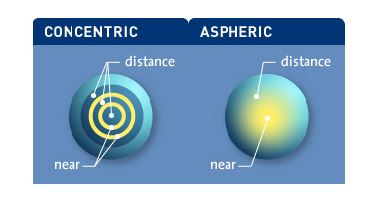Multifocals contact lenses
Multifocal Contact Lenses
Spectacles may not be an appealing option for everyone. Many people in the early stages of presbyopia who have never had vision problems previously are uncomfortable with the idea of wearing glasses for the first time in their life. They may also be image-conscious and lead active lifestyles in which glasses are inconvenient or impractical. Thankfully, contact lenses are a convenient alternative to bifocal spectacles and allow you to see clearly at all distances: up close, in the distance and in between.
Like multifocal glasses, multifocal contact lenses consist of more than one zone of vision correction. There are two common designs: concentric and aspheric. The concentric design consists of multiple rings of distance and near zones, while aspheric designs have a smooth transition from near to distance powers.
Multifocal contact lenses are designed to provide good vision to people who have a condition called presbyopia.The main sign that you're developing presbyopia is that you need to hold menus, newspapers and other reading material farther from your eyes in order to see it clearly.
multifocal contact lenses come in soft material,Some can be worn on a disposable basis. That means you have the convenience of throwing the lenses out at specified intervals (even daily, in some cases) and replacing them with fresh, new lenses.
Several lens manufacturers offer multifocal contact lenses made of silicone hydrogel material. These lenses allow significantly more oxygen to reach the cornea than conventional soft lenses for greater wearing comfort, and are available for both daily wear and extended wear.
Multifocal contact lenses have a range of powers (similar to progressive spectacle lenses) in each lens.
"Multifocal contacts" also is used as a catch-all term for all contact lenses with more than one power, including bifocal contacts.
How Multifocal Contact Lenses Work
Multifocal contact lenses work in several different ways, depending on the design of the lens. The designs fall into two basic groups:
- "Alternating vision" (translating) lenses are so named because your pupil alternates between the two powers, as your gaze shifts upward or downward.
- "Simultaneous vision" lenses require your eye to be looking through both distance and near powers at the same time. Although this might sound unworkable, your visual system learns to select the correct power choice depending on how close or far you're trying to see.
Simultaneous vision lenses come in two types: concentric ring designs and aspheric designs.

Aspheric Multifocal Contact Lenses
These multifocal contact lens designs work more like progressive eyeglass lenses, where the different prescriptive powers are blended across the lens. Unlike eyeglasses, however, aspheric contact lenses are simultaneous vision lenses, so your visual system must learn to select the proper prescription for the moment.
This is the only type of multifocal contact lens that can be described as "progressive." It's also concentric, like the concentric ring designs, and it has become the most popular type of multifocal contact lens.
Will Multifocal Contact Lenses Work for Me?
Multifocal contact lenses have been around for many years, but until recently they weren't very popular. Older bifocal designs didn't satisfy many people, leading to frustration among wearers and prescribers alike.Today, new technology has produced more successful designs, as well as a greater variety of designs. So if one design doesn't work for you, another might.
Your eye care practitioner may also try these related techniques:
- Monovision involves using single-vision lenses to put your near prescription on one eye and your distance prescription on the other.
- Modified monovision uses a single-vision lens on one eye and a multifocal lens on the other.
Which Multifocal Contact Lens is Right for Me?
Two factors that your eye care practitioner will consider in choosing a Multifocal contact lens are pupil size and your "add," or near prescription.
There are no hard and fast rules. But in general, low adds are better suited to an aspheric multifocal.Too large a pupil can be problematic for an aspheric multifocal lens.
You may need to try different multifocal contact lens designs before finding the one that's right for you. Many practitioners offer free trial lenses to help you through the process.
Keep in mind that although trial lenses are free, your eye care practitioner will still charge you for the multifocal fitting process, which can be more time-consuming than a regular contact lens fitting.
See your eye care practitoner to determine if multifocal contact lenses make sense for your needs and to identify the best lens for you.
You can always contact our customer service team over the phone on +6019 2877 766 or email your enquries to info@vfocusvisiononline.com.my, and they’ll be happy to assist you. Kindly visit our website vfocusvisiononline.com.my to check our available retail store.